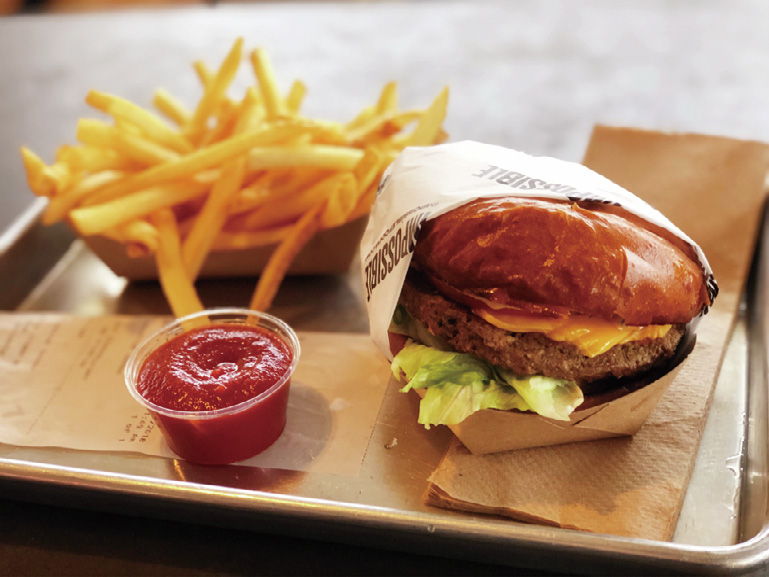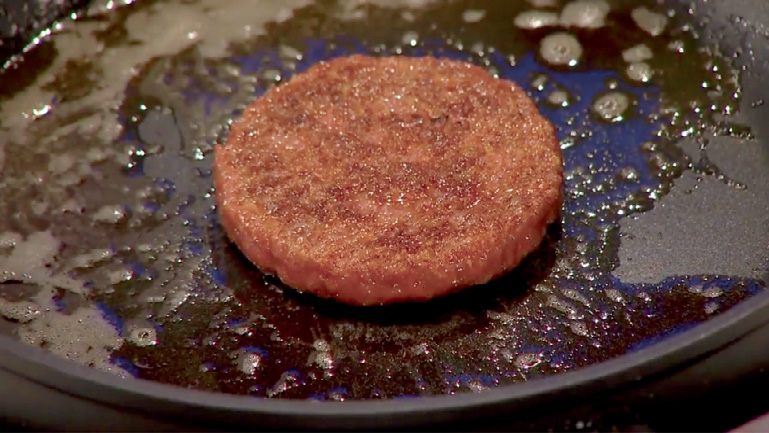On a warm, June 2019 evening at the Olympia Oyster Bar restaurant in Portland, Oregon, a group of 12 people sat down to a gourmet dinner that included salmon-based ceviche verde, crudo, and tartare (Fig. 1). But this was no ordinary meal. The salmon did not come from the sea—it was painstakingly and carefully grown over weeks, all 500 g of it, in a laboratory bioreactor [1].
《Fig. 1》

Fig. 1. This appetizer, sliced salmon on a purple-corn tortilla chip with avocado, pickled onions, and cilantro, was part of the menu at a June 2019 tasting dinner held at a restaurant in Portland, Oregon, which featured 500 g of "salmon” that took several weeks to grow in the laboratory. Credit: Wild Type, with permission.
"Guests at the tasting told us that our salmon already felt really close to their favorite salmon dishes in texture, flavor, and appearance,” said Justin Kolbeck, co-founder of Wild Type, the San Francisco-based startup company that grew the salmon. "The three chefs who prepared the food thought our salmon worked really well in a variety of culinary traditions ranging from sushi rolls to ceviche.”
Despite the dinner’s success, you should not expect to find such "salmon” in your local market any time soon. But although the experts agree there is a long way to go before purely laboratorygrown fish, chicken, or beef become commercially available, the move to create artificial meat is accelerating. More than 100 startup companies and food industry stalwarts are using technology to engineer healthier, more sustainable plant-based alternatives to farm-raised meat that look and taste (and, hopefully, cost) so much like the real thing that they appeal to both meat-eaters and vegetarians.
Among those leading the meatless meat charge is the plantbased Impossible Burger, made by the Redwood City, Californiabased startup company Impossible Foods. The company partnered with US fast food chain Burger King in August 2019 to offer its "Impossible Whopper” at all 7200 of its locations [2], bringing the total number of restaurants Impossible Foods’ burgers are served at to more than 17 000 worldwide. But consumers will not have to dine out to enjoy Impossible’s meatless burger (Fig. 2); in September 2019, the company rolled out a packaged version of its product in more than 100 grocery stores across the United States [3].
《Fig. 2》

Fig. 2. An Impossible Burger served in California in 2018. The legume-based "meat” contains a version of a small, iron-carrying molecule called heme that is produced via fermentation in giant tanks with genetically modified yeast. The heme helps an Impossible Burger remain pink in the middle as it cooks and gives it its meaty taste. Credit: Sarah Stierch, Wikimedia Commons (CC BY 4.0).
Competing for a slice of the meat-alternative pie, which could be worth as much as $85 billion USD by 2030 [4], are fellow startup Beyond Meat, which is in 20 000 grocery stores and 10 000 restaurants [5] and recently launched one of the most successful initial public offerings in nearly two decades [6], and traditional meat producers like Nestlé and Kellogg with recently released plantbased products called the "Awesome Burger” and the "Incogmeato Burger,” respectively.
And next up for Impossible Foods: plant-based pork. Announced in January 2020 [7] Impossible Pork is made from the same primary ingredients as the company’s faux beef; its protein and iron content is similar to real pork, but it contains less cholesterol, fat, and calories, and more sodium. The company plans to aggressively market its new "pork" in China, which is the world’s largest pork producer but has seen African swine fever wipe out more than a third of its hogs in recent years [7].
Unlike previous "veggie burger” options, this new wave of tech-infused products is not necessarily targeted to vegans and vegetarians. Rather, the primary goal at this point is to address concerns about meat’s impact on health and the environment.
"The market for these products is meat eaters, primarily millennials, who like the taste of meat but are driven by a desire to consume it in a more healthy, sustainable, and ethical manner,” said David Welch, director of Science and Technology at The Good Food Institute, a Washington, DC-based non-profit that supports the alternative meat industry.
Eating meat increases the risk of cardiovascular disease, type 2 diabetes, and some cancers [8]. Growing meat involves the use of antibiotics in animal feed, a practice known to promote antibiotic resistance, which is projected to cause ten million deaths a year by 2050 [9]. And avian and swine flu viruses pass easily to humans via fecal matter widely present in slaughterhouses. But the health news is not entirely positive: Most meatless burgers contain considerably more sodium than beef burgers and, relevant to the Impossible Burger, higher intake of the heme iron it contains has been associated with elevated risk of developing type 2 diabetes [10].
The potential environmental impact may be more directly compelling. Livestock production is currently responsible for 14.5% of all human-attributable greenhouse gas emissions—more than the entire transportation sector [11]. A 2018 Beyond Meat-commissioned report found that the Beyond Burger generates 90% less greenhouse gas emissions than a burger made from US beef, and requires 46% less energy, 99% less water, and 93% less land use to produce [12].
While meatless meats’ potential health and environmental benefits are attractive to many consumers, the key to getting them to put down their fish filets, turkey sandwiches, and chicken wings is to create products that faithfully replicate the taste and texture of the real thing. Impossible Foods spent more than $1 million USD creating a legume-based version of a small, iron-carrying molecule called heme, which the company produces via fermentation in giant tanks with genetically modified yeast [2]. Heme helps an Impossible Burger remain pink in the middle as it cooks and gives it its meaty taste.
Beyond Meat’s research and development efforts are equally impressive. The company’s dozens of food scientists work out of a converted aircraft hangar in California to test new products with an "E-tongue,” a two-foot compactor that mashes burgers to assess chewiness and elasticity, and an "E-nose” that isolates more than 1000 molecules in animal and plant matter to better understand how each contributes to smell and taste [5].
"What these new companies are trying to do is essentially deconstruct beef and figure out what is the right flavor, what is the right texture, the right mouthfeel, even the right aroma and look as it is cooking,” said Welch.
For consumers not quite willing to give up meat but still wanting to incorporate more plant material into their diets, there are also blended options such as Perdue’s "Chicken Plus” nuggets that mix chicken with cauliflower and chickpeas and Tyson Foods’ burger that blends beef with pea protein.
The perhaps ultimate alternative to meat is so-called "cultured” or "lab-grown” meat, like the Wild Type salmon served up at the restaurant in Portland. Bioengineers follow four main steps to create lab-grown meat: ① acquire a sample of an animal’s muscle tissue; ② break down the muscle mechanically and chemically to separate a type of stem cell called satellite cells from the muscle; ③ incubate the satellite cells in a bioreactor filled with media containing animal blood serum and other nutrients, allowing the cells to multiply into millions of specialized muscle cells called myoblasts; and ④ process small fibers of myoblasts into "meat” [13].
"The first cultured meats that will be available in the market are going to be the ground meats—the burgers, fish cakes, chicken nuggets, sausage, things like that,” said Glenn Gaudette, a professor of biomedical engineering at the Worcester Polytechnic Institute in Massachusetts.
To grow more complex lab-made meats such as steaks and chicken breasts, muscle fibers are only the first step. Meat’s signature flavor and texture require the incorporation of fat and connective tissue. "If we had a pure muscle steak it probably wouldn’t be that tasteful to most people,” Gaudette said. "You’d need to put some fat cells in there also.”
While muscle, fat, and connective tissue can all be grown in the lab, each needs its own highly specialized growth environment, making it a challenge to grow them into a single piece of meat. Bioengineers are experimenting with the most effective ways to incubate the disparate cell types together, and in a way that approximates the texture of meat.
One potential solution is to borrow from plants such as spinach, stripping individual leaves of everything but their cellular structure [14]. The fibrous leaf skeleton then becomes a scaffold in which the various cell types from beef, pork, or chicken can grow in specified patterns. Other researchers are attempting to create scaffolding out of decellularized jackfruit, apple slices, artichokes, and mushrooms. "In the end you’re left with an entirely edible scaffold that can just be taken away and eaten,” said Gaudette, whose lab is currently developing a spinach-based scaffold for cultured beef.
Beyond taste and texture, another more difficult hurdle faces the cultured meat industry. ‘‘The question that lies ahead for all of us is, what is the best way to scale the industry to get the product into as many people’s hands as possible at a reasonable cost?” said molecular biologist and cardiologist Arye Elfenbein, who co-founded Wild Type with Kolbeck. The key here is "reasonable cost.” Currently, no company has figured out how to grow cultured beef without using expensive serum derived from animal blood [14,15] (Wild Type, however, claims to be able to grow its "salmon” without serum). A single liter of the serum costs between $400 USD and $900 USD. In 2013, 50 liters were used to create the world’s first cultured burger (Fig. 3) [16].
《Fig. 3》

Fig. 3. The world’s first cultured beef hamburger was cooked at a news conference in London on 5 August 2013. The cultured meat product was grown by a team of Dutch scientists from Maastricht University at a cost of $325 000 USD [16]. Credit: World Economic Forum, Wikimedia Commons (CC BY-SA 3.0).
Scientists are also hard at work developing a synthetic serum, but even with a cheap alternative, the cost of lab-grown meat is not likely to come down enough to be competitive, said Ricardo San Martin, research director of the Alternative Meat Program at the University of California at Berkeley. He cautions that the cost of running the bioreactors and other equipment, even at factory scale, will remain high enough that conventionally grown meat and plant-based alternatives will always be at least ten times cheaper than cultured meat. "This isn’t a problem that can be solved with enthusiasm, or talent, or even money,” said San Martin. "We may see lab-grown meat end up as a very niche market.”













 京公网安备 11010502051620号
京公网安备 11010502051620号




